剑桥英语10雅思考官范文大作文 小作文.docx
cambridge10t3小作文
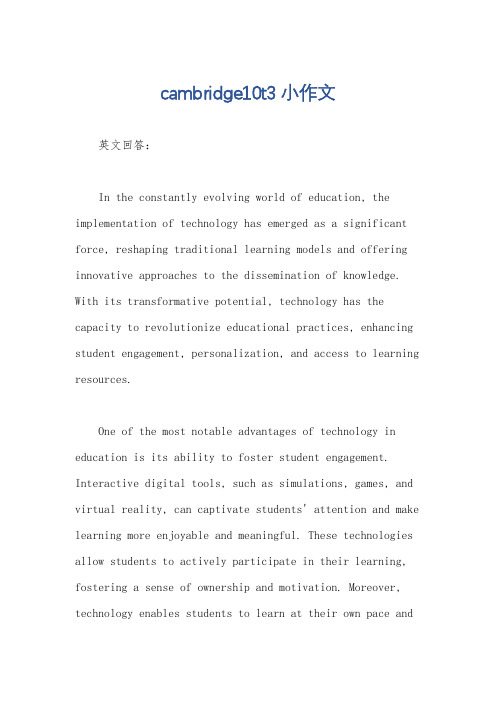
cambridge10t3小作文英文回答:In the constantly evolving world of education, the implementation of technology has emerged as a significant force, reshaping traditional learning models and offering innovative approaches to the dissemination of knowledge. With its transformative potential, technology has the capacity to revolutionize educational practices, enhancing student engagement, personalization, and access to learning resources.One of the most notable advantages of technology in education is its ability to foster student engagement. Interactive digital tools, such as simulations, games, and virtual reality, can captivate students' attention and make learning more enjoyable and meaningful. These technologies allow students to actively participate in their learning, fostering a sense of ownership and motivation. Moreover, technology enables students to learn at their own pace andexplore topics that interest them, catering to their individual learning styles and needs.Furthermore, technology facilitates the personalization of education, allowing educators to tailor instruction to the strengths and weaknesses of each student. Adaptive learning platforms, for instance, can track students' progress and adjust the difficulty level of assignments accordingly, ensuring that every learner receives an optimal learning experience. By leveraging technology, educators can provide personalized feedback and support, addressing students' specific learning needs and empowering them to reach their full potential.Technology also broadens students' access to learning resources. Online repositories, such as massive open online courses (MOOCs) and digital libraries, provide students with access to a vast wealth of knowledge and resources beyond the confines of the classroom. This eliminates geographical and socioeconomic barriers, allowing students from all backgrounds to pursue educational opportunities that may not have been available to them otherwise. Thedemocratization of education through technology empowers individuals to acquire knowledge and skills, regardless of their circumstances.However, it is important to acknowledge that the integration of technology in education is not without its challenges. Issues such as digital divide, equity, and the need for teacher training must be carefully addressed. Ensuring that all students have equal access to technology and the necessary skills to use it effectively is crucial for achieving equitable learning outcomes. Additionally, teachers require ongoing professional development to harness the full potential of technology in the classroom and to effectively integrate it into their teaching practices.In summary, technology has the power to transform education by boosting student engagement, enabling personalization, expanding access to learning resources, and promoting lifelong learning. However, it is imperative to address the challenges associated with its implementation and to ensure that all students haveequitable access to and benefit from its transformative potential.中文回答:科技在教育领域的发展日新月异,为传统的教育模式带来了革命性的影响。
雅思剑10t2小作文范文
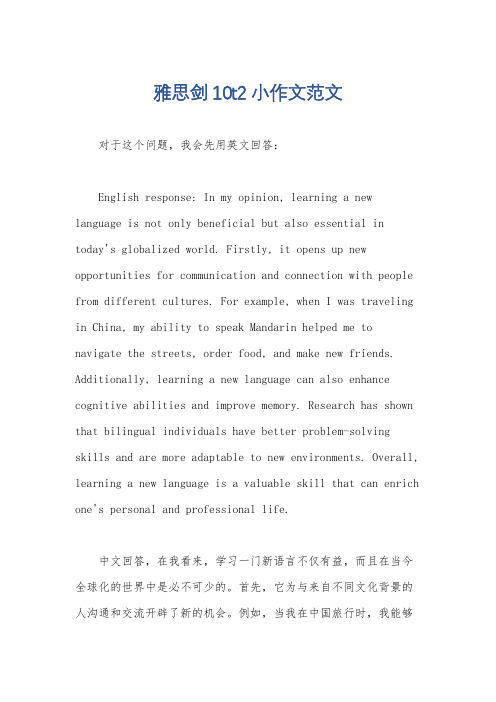
雅思剑10t2小作文范文对于这个问题,我会先用英文回答:English response: In my opinion, learning a new language is not only beneficial but also essential intoday's globalized world. Firstly, it opens up new opportunities for communication and connection with people from different cultures. For example, when I was traveling in China, my ability to speak Mandarin helped me to navigate the streets, order food, and make new friends. Additionally, learning a new language can also enhance cognitive abilities and improve memory. Research has shown that bilingual individuals have better problem-solving skills and are more adaptable to new environments. Overall, learning a new language is a valuable skill that can enrich one's personal and professional life.中文回答,在我看来,学习一门新语言不仅有益,而且在当今全球化的世界中是必不可少的。
首先,它为与来自不同文化背景的人沟通和交流开辟了新的机会。
例如,当我在中国旅行时,我能够说普通话帮助我在街上找路、点餐和交新朋友。
雅思10test1作文
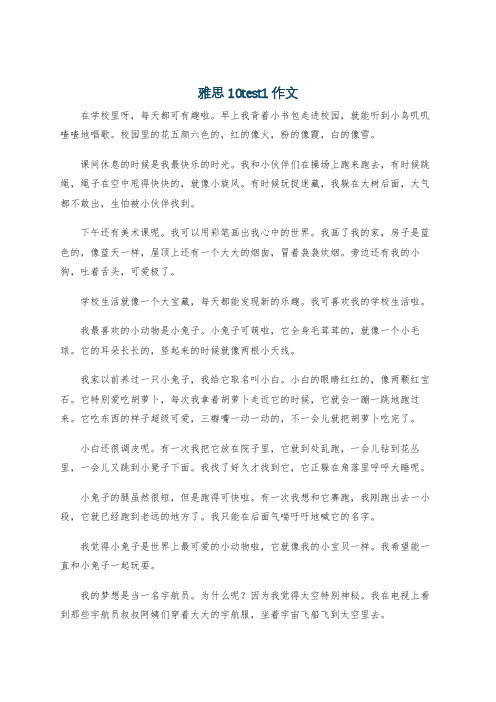
雅思10test1作文在学校里呀,每天都可有趣啦。
早上我背着小书包走进校园,就能听到小鸟叽叽喳喳地唱歌。
校园里的花五颜六色的,红的像火,粉的像霞,白的像雪。
课间休息的时候是我最快乐的时光。
我和小伙伴们在操场上跑来跑去,有时候跳绳,绳子在空中甩得快快的,就像小旋风。
有时候玩捉迷藏,我躲在大树后面,大气都不敢出,生怕被小伙伴找到。
下午还有美术课呢。
我可以用彩笔画出我心中的世界。
我画了我的家,房子是蓝色的,像蓝天一样,屋顶上还有一个大大的烟囱,冒着袅袅炊烟。
旁边还有我的小狗,吐着舌头,可爱极了。
学校生活就像一个大宝藏,每天都能发现新的乐趣。
我可喜欢我的学校生活啦。
我最喜欢的小动物是小兔子。
小兔子可萌啦,它全身毛茸茸的,就像一个小毛球。
它的耳朵长长的,竖起来的时候就像两根小天线。
我家以前养过一只小兔子,我给它取名叫小白。
小白的眼睛红红的,像两颗红宝石。
它特别爱吃胡萝卜,每次我拿着胡萝卜走近它的时候,它就会一蹦一跳地跑过来。
它吃东西的样子超级可爱,三瓣嘴一动一动的,不一会儿就把胡萝卜吃完了。
小白还很调皮呢。
有一次我把它放在院子里,它就到处乱跑,一会儿钻到花丛里,一会儿又跳到小凳子下面。
我找了好久才找到它,它正躲在角落里呼呼大睡呢。
小兔子的腿虽然很短,但是跑得可快啦。
有一次我想和它赛跑,我刚跑出去一小段,它就已经跑到老远的地方了。
我只能在后面气喘吁吁地喊它的名字。
我觉得小兔子是世界上最可爱的小动物啦,它就像我的小宝贝一样。
我希望能一直和小兔子一起玩耍。
我的梦想是当一名宇航员。
为什么呢?因为我觉得太空特别神秘。
我在电视上看到那些宇航员叔叔阿姨们穿着大大的宇航服,坐着宇宙飞船飞到太空里去。
太空里有好多星星,一闪一闪的,就像小眼睛在眨呀眨。
我想飞到那些星星旁边,看看它们到底是什么样子的。
我还想看看月亮上有没有嫦娥姐姐和玉兔呢。
我知道当宇航员可不容易啦。
要学习好多知识,像数学知识,这样才能计算飞船的飞行轨道。
还要学习科学知识,了解太空里的各种东西。
剑10test1小作文考官范文(精选5篇)

剑10test1小作文考官范文(精选5篇)(经典版)编制人:__________________审核人:__________________审批人:__________________编制单位:__________________编制时间:____年____月____日序言下载提示:该文档是本店铺精心编制而成的,希望大家下载后,能够帮助大家解决实际问题。
文档下载后可定制修改,请根据实际需要进行调整和使用,谢谢!并且,本店铺为大家提供各种类型的经典范文,如工作总结、工作计划、合同协议、条据文书、策划方案、句子大全、作文大全、诗词歌赋、教案资料、其他范文等等,想了解不同范文格式和写法,敬请关注!Download tips: This document is carefully compiled by this editor. I hope that after you download it, it can help you solve practical problems. The document can be customized and modified after downloading, please adjust and use it according to actual needs, thank you!Moreover, our store provides various types of classic sample essays for everyone, such as work summaries, work plans, contract agreements, doctrinal documents, planning plans, complete sentences, complete compositions, poems, songs, teaching materials, and other sample essays. If you want to learn about different sample formats and writing methods, please stay tuned!剑10test1小作文考官范文(精选5篇)剑10test1小作文考官范文第1篇It is important for children to learn the difference between right and wrong at an early age.Punishment is necessary to help them learn this distinction.To what eXtent do you agree or disagree with this opinion?What sort of punishment should parents and teachers be allowed to use to teach good behaviour to children?1.话题和题型分类教育类,同意不同意型2.题目分析孩子们在早期学习分辨是非很重要,对于学习分辨是非,惩罚是很重要的,你是否同意这种观点,并说明哪些惩罚你认为是可以允许的。
雅思小作文范文10篇

雅思小作文范文10篇英文回答:1. Write a letter to your friend describing your new house.Dear [Friend's Name],。
I hope this letter finds you well. I'm writing to you today to tell you all about my new house! I'm so excited to finally have a place of my own, and I know you're going to love it too.The house is located in a quiet neighborhood, and it's just a short walk from the beach. It's a two-story house with three bedrooms and two bathrooms. The kitchen is spacious and has all the appliances I need. The living room is cozy and has a fireplace. The backyard is fenced in and has a patio and a fire pit.I've been living in the house for about a month now, and I'm really starting to feel at home. I love cooking in the kitchen, and I've been spending a lot of time reading in the living room. The backyard is perfect for entertaining, and I've already had a few friends over for BBQs.I know you're coming to visit next month, and I can't wait to show you my new house. I think you're going to love it as much as I do.Love,。
剑雅10t1小作文范文

剑雅10t1小作文范文英文回答:In my opinion, learning a second language is extremely beneficial. Not only does it open up a whole new world of opportunities, but it also helps to broaden one's horizons and enhance communication skills.Firstly, learning a second language provides numerous career advantages. In today's globalized world, companies are increasingly seeking individuals who are bilingual or multilingual. Being able to communicate with people from different countries and cultures is a valuable skill that can lead to better job prospects and higher salaries. For example, if a person is fluent in both English and Mandarin, they can work as a translator or interpreter, which can bea highly lucrative profession.Secondly, learning a second language allows for better cultural understanding and appreciation. Language isclosely tied to culture, and by learning a new language, one gains insight into the customs, traditions, and values of the people who speak it. This knowledge can foster empathy and promote cross-cultural understanding. For instance, if I am able to speak Spanish, I can better understand and connect with the Hispanic community in my city, which can lead to more meaningful relationships and a greater appreciation for their culture.Furthermore, learning a second language improves cognitive abilities. Studies have shown that bilingual individuals have better problem-solving skills, enhanced memory, and improved multitasking abilities. This is because learning a new language requires the brain to adapt and switch between different linguistic systems. For example, when I was learning French, I had to constantly switch between English and French grammar rules, which helped to sharpen my analytical thinking skills.Lastly, learning a second language can be a fun and rewarding experience. It allows us to connect with people from different backgrounds and engage in meaningfulconversations. It also opens up a whole new world of literature, music, and films that would otherwise be inaccessible. For instance, being able to read Gabriel Garcia Marquez's "One Hundred Years of Solitude" in its original Spanish version or watching a French film without subtitles can provide a deeper understanding and enjoyment of the work.中文回答:在我看来,学习第二语言是非常有益的。
剑桥英语雅思考官大作文小作文

剑桥英语雅思考官大作文小作文文档编制序号:[KKIDT-LLE0828-LLETD298-POI08]剑10 1-2It is important for children to learn the difference between right and wrong at an early age. Punishment is necessary to help them learn this distinction.To what extent do you agree or disagree with this opinionWhat sort of punishment should parents and teachers be allowed to use to teach good behavior to childrenOne important stage in a child’s growth is certainly the development of a conscience, which is linked to the ability to tell right from wrong. This skill comes with time and good parenting, and my firm conviction is that punishment does not have much of a role to play in this. Therefore I have to disagree almost entirely with the given statement.To some extent the question depends on the age of the child. To punish a very young child is both wrong and foolish, as an infant will not understand what is happening or why he or she is being punished. Once the age of reason is reached however, a child can be rewarded for good behavior and discouraged from bad. This kind but firm approach will achieve more than harsh punishments, which might entail many negative consequences unintended by the parents.To help a child learn the difference between right and wrong, teachers and parents should firstly provide good role modelling in their own behavior. After that, if sanctions are needed, the punishment should not be of a physical nature, as that merely sends the message that it is acceptable for larger people to hit smaller ones-an outcome which may well result in the child starting to bully others. Nor should the punishment be in any way cruel.Rather, teachers and parents can use a variety of methods to discipline their young charges, such as detention, withdrawal of privileges, and time-out. Making the punishment fit the crime is a useful notion. Which would see children being made to pick up rubbish they have dropped, clean up graffiti they have drawn, or apologise to someone they have hurt. In these ways responsibility is developed in the child, which leads to much better future behavior than does punishment.剑10 2-1The tables below give information about sales of Fairtrade-labelled coffee and bananas in 1999 and 2004 in five European countries. Summarise the information by selecting and reporting the main features, and make comparisons where relevant.The two tables contain sales date for Fairtrade coffee and bananas in 1999 and 2004, in five nations of Europe.The first shows low-level coffee sales increasing in all five countries, albeit to widely varying degrees. In two places sales increased by the same small amount: million euros in Denmark, and million in Sweden. The increment was slightly larger in Belgium, from million euros. Meanwhile, in Switzerland sales doubled from 3-6 million euros. Finally, in the UK there was an enormous increase, from million euros.In the second table, it is Switzerland which stands out as buying far more Fairtrade bananas than the other four countries. Swiss sales figures jumped from 15-47 million euros across these five years, while in the UK and Belgium sales only grew from and from million euros respectively. Sweden and Denmark showed a different pattern, with fails in banana sales from and million euros.Comparing the two tables, it is clear that in 1999 Fairtrade coffee sales ranged from million euros in these five countries, while banana sales alsomostly cluster between and 2 million euros, with Switzerland the outlier at a huge 15 million euros. By 2004, sales figures for both products had risen across the board, except for Sweden and Demark which recorded drops in banana sales.剑10 3-2Countries are becoming more and more similar because people are able to buy the same products anywhere in the world.Do you think this is a positive or negative developmentIt is said that countries are becoming similar to each other because of the global spread of the same products, which are now available for purchase almost anywhere. I strongly believe that this modern development is largely detrimental to culture and traditions worldwide.A country’s history, language and ethos are all inextricably bound up in its manufactured artefacts. If the relentless advance of international brands into every corner of the world continues, these bland packages might one day completely oust the traditional objects of a nation, which would be a loss of richness and diversity in the world, as well as the sad disappearance of the manifestations of a place’s character. What would a Japanese tea ceremony be without its specially crafted teapot, or a Fijian kava ritual without its bowl made from a certain type of tree barkLet us not forget either that traditional products, whether these be medicines, cosmetics, toys, clothes, utensils or food, provide employment for local people. The spread of multinational products can often bring in its wake a loss of jobs, as people turn to buying the new brand, perhaps thinking it more glamorous than the one they are used to. This eventually puts old-school craftspeople out of work.Finally, tourism numbers may also be affected, as travellers become disillusioned with finding every place just the same as the one they visitedpreviously. To see the same products in shops the world over is boring, and does not impel visitors to open their wallets in the same way that trinkets or souvenirs unique to the particular area do.Some may argue that all people are entitled to have access to the same products, but I say that local objects suit local conditions best, and that faceless uniformity worldwide is an unwelcome and dreary prospect.剑10 4-1The diagrams below show the life cycle of a species of large fish called the salmon.Summarise the information by selecting and reporting the main features, and make comparisons where relevant.Salmon begin life as eggs on a pebbly riverbed, hidden among reeds in the slow-moving upper reaches of a river. After five to six months the eggs hatch into “fry”. For approximately the next four years, these baby salmon will live in the lower, faster-flowing waters of their river. During this time they measure between three and eight centimetres in length.By the time salmon reach twelve to fifteen centimetres, they are termed ‘smolt’, and at this time they migrate further downriver into the open sea. After five years at sea the salmon will have grown to adult size, which is between seventy and seventy-six centimetres. They then begin swimming back to their birthplace, where they will lay their eggs, and the cycle starts anew.In summary, the salmon passes through three distinct physical stages as it grows to maturity. Each of these stages takes place in a very different aquatic location. It is noteworthy that the first two stages of this fish’s life occur in a freshwater environment, while the third stage is lived in saltwater.。
剑桥英语10雅思考官范文(大作文+小作文)教学内容
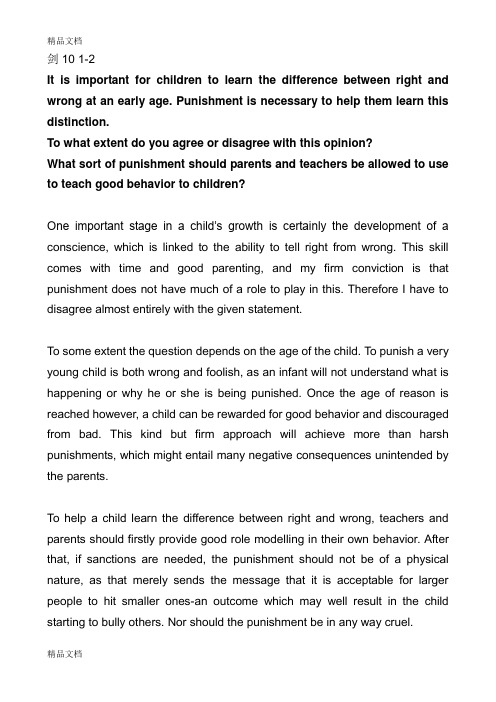
剑10 1-2It is important for children to learn the difference between right and wrong at an early age. Punishment is necessary to help them learn this distinction.To what extent do you agree or disagree with this opinion?What sort of punishment should parents and teachers be allowed to use to teach good behavior to children?One important stage in a child’s growth is certainly the development of a conscience, which is linked to the ability to tell right from wrong. This skill comes with time and good parenting, and my firm conviction is that punishment does not have much of a role to play in this. Therefore I have to disagree almost entirely with the given statement.To some extent the question depends on the age of the child. To punish a very young child is both wrong and foolish, as an infant will not understand what is happening or why he or she is being punished. Once the age of reason is reached however, a child can be rewarded for good behavior and discouraged from bad. This kind but firm approach will achieve more than harsh punishments, which might entail many negative consequences unintended by the parents.To help a child learn the difference between right and wrong, teachers and parents should firstly provide good role modelling in their own behavior. After that, if sanctions are needed, the punishment should not be of a physical nature, as that merely sends the message that it is acceptable for larger people to hit smaller ones-an outcome which may well result in the child starting to bully others. Nor should the punishment be in any way cruel.Rather, teachers and parents can use a variety of methods to discipline their young charges, such as detention, withdrawal of privileges, and time-out. Making the punishment fit the crime is a useful notion. Which would see children being made to pick up rubbish they have dropped, clean up graffiti they have drawn, or apologise to someone they have hurt. In these ways responsibility is developed in the child, which leads to much better future behavior than does punishment.剑10 2-1The tables below give information about sales of Fairtrade-labelled coffee and bananas in 1999 and 2004 in five European countries. Summarise the information by selecting and reporting the main features, and make comparisons where relevant.The two tables contain sales date for Fairtrade coffee and bananas in 1999 and 2004, in five nations of Europe.The first shows low-level coffee sales increasing in all five countries, albeit to widely varying degrees. In two places sales increased by the same small amount: 1.8-2 million euros in Denmark, and 0.8-1 million in Sweden. The increment was slightly larger in Belgium, from 1-1.7 million euros. Meanwhile, in Switzerland sales doubled from 3-6 million euros. Finally, in the UK there was an enormous increase, from 1.5-20 million euros.In the second table, it is Switzerland which stands out as buying far more Fairtrade bananas than the other four countries. Swiss sales figures jumpedfrom 15-47 million euros across these five years, while in the UK and Belgium sales only grew from 1-5.5 and from 0.6-4 million euros respectively. Sweden and Denmark showed a different pattern, with fails in banana sales from 1.8-1 and 2-0.9 million euros.Comparing the two tables, it is clear that in 1999 Fairtrade coffee sales ranged from 0.8-3 million euros in these five countries, while banana sales also mostly cluster between 0.6 and 2 million euros, with Switzerland the outlier at a huge 15 million euros. By 2004, sales figures for both products had risen across the board, except for Sweden and Demark which recorded drops in banana sales.剑10 3-2Countries are becoming more and more similar because people are able to buy the same products anywhere in the world.Do you think this is a positive or negative development?It is said that countries are becoming similar to each other because of the global spread of the same products, which are now available for purchase almost anywhere. I strongly believe that this modern development is largely detrimental to culture and traditions worldwide.A country’s history, language and ethos are all inextricably bound up in its manufactured artefacts. If the relentless advance of international brands into every corner of the world continues, these bland packages might one day completely oust the traditional objects of a nation, which would be a loss of richness and diversity in the world, as well as the sad disappearance of the manifestations of a place’s character. What would a Japanese tea ceremony be without its specially crafted teapot, or a Fijian kava ritual without its bowlmade from a certain type of tree bark?Let us not forget either that traditional products, whether these be medicines, cosmetics, toys, clothes, utensils or food, provide employment for local people. The spread of multinational products can often bring in its wake a loss of jobs, as people turn to buying the new brand, perhaps thinking it more glamorous than the one they are used to. This eventually puts old-school craftspeople out of work.Finally, tourism numbers may also be affected, as travellers become disillusioned with finding every place just the same as the one they visited previously. To see the same products in shops the world over is boring, and does not impel visitors to open their wallets in the same way that trinkets or souvenirs unique to the particular area do.Some may argue that all people are entitled to have access to the same products, but I say that local objects suit local conditions best, and that faceless uniformity worldwide is an unwelcome and dreary prospect.剑10 4-1The diagrams below show the life cycle of a species of large fish called the salmon.Summarise the information by selecting and reporting the main features, and make comparisons where relevant.Salmon begin life as eggs on a pebbly riverbed, hidden among reeds in the slow-moving upper reaches of a river. After five to six months the eggs hatch into “fry”. For approximately the next four years, these baby salmon will live in the lower, faster-flowing waters of their river. During this time they measure between three and eight centimetres in length.By the time salmon reach twelve to fifteen centimetres, they are termed ‘smolt’, and at this time they migrate further downriver into the open sea. After five years at sea the salmon will have grown to adult size, which is between seventy and seventy-six centimetres. They then begin swimming back to their birthplace, where they will lay their eggs, and the cycle starts anew.In summary, the salmon passes through three distinct physical stages as it grows to maturity. Each of these stages takes place in a very different aquatic location. It is noteworthy that the first two stages of this fish’s life occur in a freshwater environment, while the third stage is lived in saltwater.。
剑桥雅思10text3小作文
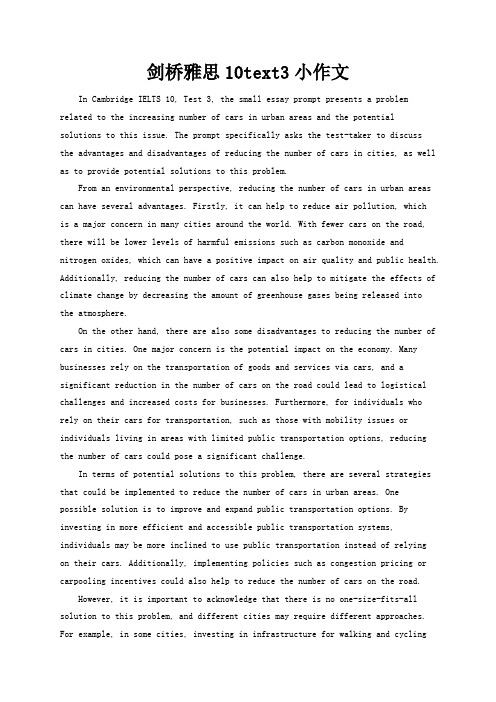
剑桥雅思10text3小作文In Cambridge IELTS 10, Test 3, the small essay prompt presents a problemrelated to the increasing number of cars in urban areas and the potentialsolutions to this issue. The prompt specifically asks the test-taker to discussthe advantages and disadvantages of reducing the number of cars in cities, as well as to provide potential solutions to this problem.From an environmental perspective, reducing the number of cars in urban areas can have several advantages. Firstly, it can help to reduce air pollution, whichis a major concern in many cities around the world. With fewer cars on the road, there will be lower levels of harmful emissions such as carbon monoxide and nitrogen oxides, which can have a positive impact on air quality and public health. Additionally, reducing the number of cars can also help to mitigate the effects of climate change by decreasing the amount of greenhouse gases being released intothe atmosphere.On the other hand, there are also some disadvantages to reducing the number of cars in cities. One major concern is the potential impact on the economy. Many businesses rely on the transportation of goods and services via cars, and a significant reduction in the number of cars on the road could lead to logistical challenges and increased costs for businesses. Furthermore, for individuals whorely on their cars for transportation, such as those with mobility issues or individuals living in areas with limited public transportation options, reducing the number of cars could pose a significant challenge.In terms of potential solutions to this problem, there are several strategies that could be implemented to reduce the number of cars in urban areas. Onepossible solution is to improve and expand public transportation options. By investing in more efficient and accessible public transportation systems, individuals may be more inclined to use public transportation instead of relyingon their cars. Additionally, implementing policies such as congestion pricing or carpooling incentives could also help to reduce the number of cars on the road.However, it is important to acknowledge that there is no one-size-fits-all solution to this problem, and different cities may require different approaches. For example, in some cities, investing in infrastructure for walking and cyclingmay be more effective, while in others, implementing stricter emissions standards for vehicles may be necessary.In conclusion, the problem of the increasing number of cars in urban areas is a complex issue that requires careful consideration of its various implications. While there are clear environmental benefits to reducing the number of cars, it is also important to consider the potential economic and social impacts of such policies. By exploring a range of potential solutions and considering the unique needs of different cities, it may be possible to develop effective strategies for addressing this problem.。
(完整版)剑桥英语10雅思考官范文(大作文小作文)
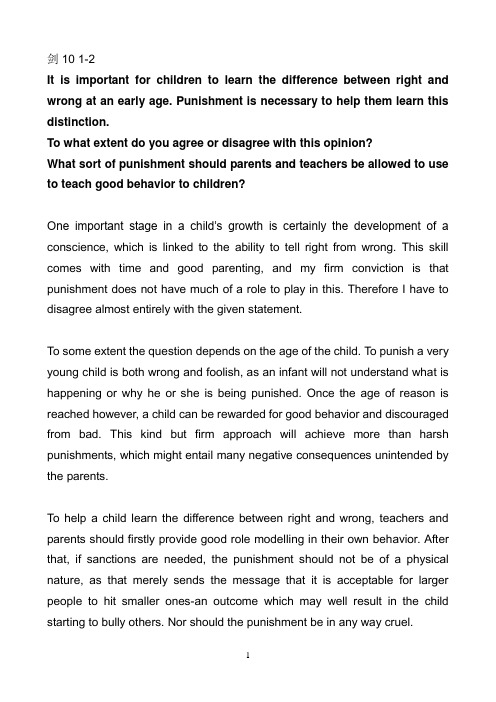
剑10 1-2It is important for children to learn the difference between right and wrong at an early age. Punishment is necessary to help them learn this distinction.To what extent do you agree or disagree with this opinion?What sort of punishment should parents and teachers be allowed to use to teach good behavior to children?One important stage in a child’s growth is certainly the development of a conscience, which is linked to the ability to tell right from wrong. This skill comes with time and good parenting, and my firm conviction is that punishment does not have much of a role to play in this. Therefore I have to disagree almost entirely with the given statement.To some extent the question depends on the age of the child. To punish a very young child is both wrong and foolish, as an infant will not understand what is happening or why he or she is being punished. Once the age of reason is reached however, a child can be rewarded for good behavior and discouraged from bad. This kind but firm approach will achieve more than harsh punishments, which might entail many negative consequences unintended by the parents.To help a child learn the difference between right and wrong, teachers and parents should firstly provide good role modelling in their own behavior. After that, if sanctions are needed, the punishment should not be of a physical nature, as that merely sends the message that it is acceptable for larger people to hit smaller ones-an outcome which may well result in the child starting to bully others. Nor should the punishment be in any way cruel.Rather, teachers and parents can use a variety of methods to discipline their young charges, such as detention, withdrawal of privileges, and time-out. Making the punishment fit the crime is a useful notion. Which would see children being made to pick up rubbish they have dropped, clean up graffiti they have drawn, or apologise to someone they have hurt. In these ways responsibility is developed in the child, which leads to much better future behavior than does punishment.剑10 2-1The tables below give information about sales of Fairtrade-labelled coffee and bananas in 1999 and 2004 in five European countries. Summarise the information by selecting and reporting the main features, and make comparisons where relevant.The two tables contain sales date for Fairtrade coffee and bananas in 1999 and 2004, in five nations of Europe.The first shows low-level coffee sales increasing in all five countries, albeit to widely varying degrees. In two places sales increased by the same small amount: 1.8-2 million euros in Denmark, and 0.8-1 million in Sweden. The increment was slightly larger in Belgium, from 1-1.7 million euros. Meanwhile, in Switzerland sales doubled from 3-6 million euros. Finally, in the UK there was an enormous increase, from 1.5-20 million euros.In the second table, it is Switzerland which stands out as buying far more Fairtrade bananas than the other four countries. Swiss sales figures jumpedfrom 15-47 million euros across these five years, while in the UK and Belgium sales only grew from 1-5.5 and from 0.6-4 million euros respectively. Sweden and Denmark showed a different pattern, with fails in banana sales from 1.8-1 and 2-0.9 million euros.Comparing the two tables, it is clear that in 1999 Fairtrade coffee sales ranged from 0.8-3 million euros in these five countries, while banana sales also mostly cluster between 0.6 and 2 million euros, with Switzerland the outlier at a huge 15 million euros. By 2004, sales figures for both products had risen across the board, except for Sweden and Demark which recorded drops in banana sales.剑10 3-2Countries are becoming more and more similar because people are able to buy the same products anywhere in the world.Do you think this is a positive or negative development?It is said that countries are becoming similar to each other because of the global spread of the same products, which are now available for purchase almost anywhere. I strongly believe that this modern development is largely detrimental to culture and traditions worldwide.A country’s history, language and ethos are all inextricably bound up in its manufactured artefacts. If the relentless advance of international brands into every corner of the world continues, these bland packages might one day completely oust the traditional objects of a nation, which would be a loss of richness and diversity in the world, as well as the sad disappearance of the manifestations of a place’s character. What would a Japanese tea ceremony be without its specially crafted teapot, or a Fijian kava ritual without its bowlmade from a certain type of tree bark?Let us not forget either that traditional products, whether these be medicines, cosmetics, toys, clothes, utensils or food, provide employment for local people. The spread of multinational products can often bring in its wake a loss of jobs, as people turn to buying the new brand, perhaps thinking it more glamorous than the one they are used to. This eventually puts old-school craftspeople out of work.Finally, tourism numbers may also be affected, as travellers become disillusioned with finding every place just the same as the one they visited previously. To see the same products in shops the world over is boring, and does not impel visitors to open their wallets in the same way that trinkets or souvenirs unique to the particular area do.Some may argue that all people are entitled to have access to the same products, but I say that local objects suit local conditions best, and that faceless uniformity worldwide is an unwelcome and dreary prospect.剑10 4-1The diagrams below show the life cycle of a species of large fish called the salmon.Summarise the information by selecting and reporting the main features, and make comparisons where relevant.Salmon begin life as eggs on a pebbly riverbed, hidden among reeds in the slow-moving upper reaches of a river. After five to six months the eggs hatch into “fry”. For approximately the next four years, these baby salmon will live in the lower, faster-flowing waters of their river. During this time they measure between three and eight centimetres in length.By the time salmon reach twelve to fifteen centimetres, they are termed ‘smolt’, and at this time they migrate further downriver into the open sea. After five years at sea the salmon will have grown to adult size, which is between seventy and seventy-six centimetres. They then begin swimming back to their birthplace, where they will lay their eggs, and the cycle starts anew.In summary, the salmon passes through three distinct physical stages as it grows to maturity. Each of these stages takes place in a very different aquatic location. It is noteworthy that the first two stages of this fish’s life occur in a freshwater environment, while the third stage is lived in saltwater.。
雅思10test1写作小作文
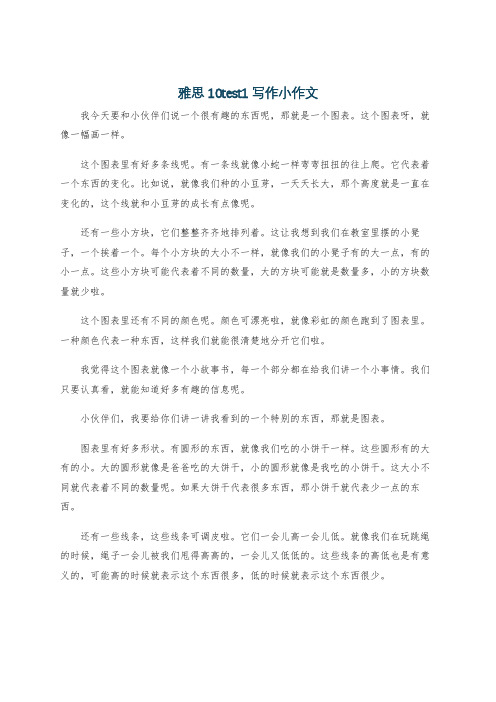
雅思10test1写作小作文我今天要和小伙伴们说一个很有趣的东西呢,那就是一个图表。
这个图表呀,就像一幅画一样。
这个图表里有好多条线呢。
有一条线就像小蛇一样弯弯扭扭的往上爬。
它代表着一个东西的变化。
比如说,就像我们种的小豆芽,一天天长大,那个高度就是一直在变化的,这个线就和小豆芽的成长有点像呢。
还有一些小方块,它们整整齐齐地排列着。
这让我想到我们在教室里摆的小凳子,一个挨着一个。
每个小方块的大小不一样,就像我们的小凳子有的大一点,有的小一点。
这些小方块可能代表着不同的数量,大的方块可能就是数量多,小的方块数量就少啦。
这个图表里还有不同的颜色呢。
颜色可漂亮啦,就像彩虹的颜色跑到了图表里。
一种颜色代表一种东西,这样我们就能很清楚地分开它们啦。
我觉得这个图表就像一个小故事书,每一个部分都在给我们讲一个小事情。
我们只要认真看,就能知道好多有趣的信息呢。
小伙伴们,我要给你们讲一讲我看到的一个特别的东西,那就是图表。
图表里有好多形状。
有圆形的东西,就像我们吃的小饼干一样。
这些圆形有的大有的小。
大的圆形就像是爸爸吃的大饼干,小的圆形就像是我吃的小饼干。
这大小不同就代表着不同的数量呢。
如果大饼干代表很多东西,那小饼干就代表少一点的东西。
还有一些线条,这些线条可调皮啦。
它们一会儿高一会儿低。
就像我们在玩跳绳的时候,绳子一会儿被我们甩得高高的,一会儿又低低的。
这些线条的高低也是有意义的,可能高的时候就表示这个东西很多,低的时候就表示这个东西很少。
这个图表还有一些小标记呢。
就像我们在寻宝图上做的小记号一样。
这些小标记告诉我们这个部分是什么意思。
比如说有一个小箭头,它可能就指着一个很重要的东西,就像箭头指着宝藏在哪里一样。
我看这个图表的时候,就感觉像是在玩一个很有趣的游戏。
只要我认真看,就能找到好多好玩的秘密呢。
小朋友们。
今天我想和你们聊聊一个超级神奇的图表。
这个图表里有一些长长的条,就像我们吃的长长的薯条一样。
不过这些条有长有短。
剑桥英语10雅思考官范文(大作文+小作文)doc资料
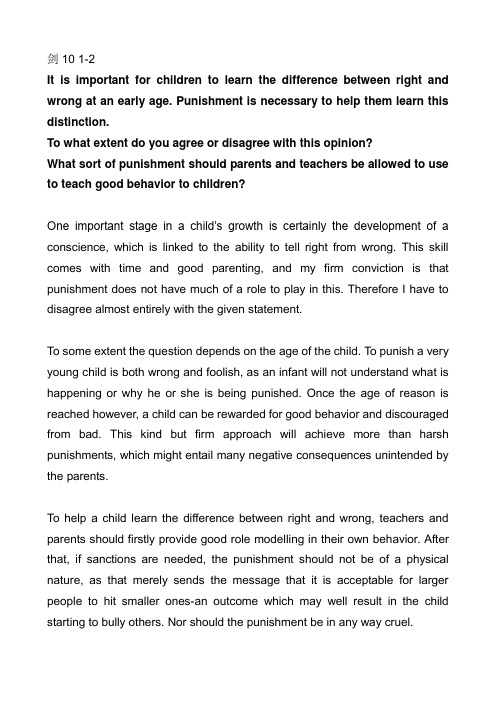
剑10 1-2It is important for children to learn the difference between right and wrong at an early age. Punishment is necessary to help them learn this distinction.To what extent do you agree or disagree with this opinion?What sort of punishment should parents and teachers be allowed to use to teach good behavior to children?One important stage in a child’s growth is certainly the development of a conscience, which is linked to the ability to tell right from wrong. This skill comes with time and good parenting, and my firm conviction is that punishment does not have much of a role to play in this. Therefore I have to disagree almost entirely with the given statement.To some extent the question depends on the age of the child. To punish a very young child is both wrong and foolish, as an infant will not understand what is happening or why he or she is being punished. Once the age of reason is reached however, a child can be rewarded for good behavior and discouraged from bad. This kind but firm approach will achieve more than harsh punishments, which might entail many negative consequences unintended by the parents.To help a child learn the difference between right and wrong, teachers and parents should firstly provide good role modelling in their own behavior. After that, if sanctions are needed, the punishment should not be of a physical nature, as that merely sends the message that it is acceptable for larger people to hit smaller ones-an outcome which may well result in the child starting to bully others. Nor should the punishment be in any way cruel.Rather, teachers and parents can use a variety of methods to discipline their young charges, such as detention, withdrawal of privileges, and time-out. Making the punishment fit the crime is a useful notion. Which would see children being made to pick up rubbish they have dropped, clean up graffiti they have drawn, or apologise to someone they have hurt. In these ways responsibility is developed in the child, which leads to much better future behavior than does punishment.剑10 2-1The tables below give information about sales of Fairtrade-labelled coffee and bananas in 1999 and 2004 in five European countries. Summarise the information by selecting and reporting the main features, and make comparisons where relevant.The two tables contain sales date for Fairtrade coffee and bananas in 1999 and 2004, in five nations of Europe.The first shows low-level coffee sales increasing in all five countries, albeit to widely varying degrees. In two places sales increased by the same small amount: 1.8-2 million euros in Denmark, and 0.8-1 million in Sweden. The increment was slightly larger in Belgium, from 1-1.7 million euros. Meanwhile, in Switzerland sales doubled from 3-6 million euros. Finally, in the UK there was an enormous increase, from 1.5-20 million euros.In the second table, it is Switzerland which stands out as buying far more Fairtrade bananas than the other four countries. Swiss sales figures jumped from 15-47 million euros across these five years, while in the UK and Belgium sales only grew from 1-5.5 and from 0.6-4 million euros respectively. Sweden and Denmark showed a different pattern, with fails in banana sales from 1.8-1 and 2-0.9 million euros.Comparing the two tables, it is clear that in 1999 Fairtrade coffee sales ranged from 0.8-3 million euros in these five countries, while banana sales also mostly cluster between 0.6 and 2 million euros, with Switzerland the outlier at a huge 15 million euros. By 2004, sales figures for both products had risen across the board, except for Sweden and Demark which recorded drops in banana sales.剑10 3-2Countries are becoming more and more similar because people are able to buy the same products anywhere in the world.Do you think this is a positive or negative development?It is said that countries are becoming similar to each other because of theglobal spread of the same products, which are now available for purchase almost anywhere. I strongly believe that this modern development is largely detrimental to culture and traditions worldwide.A country’s history, language and ethos are all inextricably bound up in its manufactured artefacts. If the relentless advance of international brands into every corner of the world continues, these bland packages might one day completely oust the traditional objects of a nation, which would be a loss of richness and diversity in the world, as well as the sad disappearance of the manifestations of a place’s character. What would a Japanese tea ceremony be without its specially crafted teapot, or a Fijian kava ritual without its bowl made from a certain type of tree bark?Let us not forget either that traditional products, whether these be medicines, cosmetics, toys, clothes, utensils or food, provide employment for local people. The spread of multinational products can often bring in its wake a loss of jobs, as people turn to buying the new brand, perhaps thinking it more glamorous than the one they are used to. This eventually puts old-school craftspeople out of work.Finally, tourism numbers may also be affected, as travellers become disillusioned with finding every place just the same as the one they visited previously. To see the same products in shops the world over is boring, and does not impel visitors to open their wallets in the same way that trinkets or souvenirs unique to the particular area do.Some may argue that all people are entitled to have access to the same products, but I say that local objects suit local conditions best, and that faceless uniformity worldwide is an unwelcome and dreary prospect.剑10 4-1The diagrams below show the life cycle of a species of large fish called the salmon.Summarise the information by selecting and reporting the main features, and make comparisons where relevant.Salmon begin life as eggs on a pebbly riverbed, hidden among reeds in the slow-moving upper reaches of a river. After five to six months the eggs hatch into “fry”. For approximately the next four years, these baby salmon will live in the lower, faster-flowing waters of their river. During this time they measure between three and eight centimetres in length.By the time salmon reach twelve to fifteen centimetres, they are termed ‘smolt’, and at this time they migrate further downriver into the open sea. After five years at sea the salmon will have grown to adult size, which is between seventy and seventy-six centimetres. They then begin swimming back to their birthplace, where they will lay their eggs, and the cycle starts anew.In summary, the salmon passes through three distinct physical stages as it grows to maturity. Each of these stages takes place in a very different aquatic location. It is noteworthy that the first two stages of this fish’s life occur in a freshwater environment, while the third stage is lived in saltwater.。
雅思剑10-4小作文
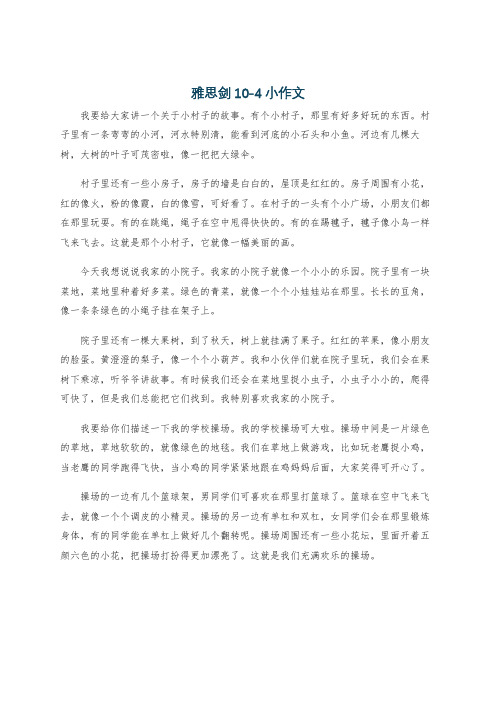
雅思剑10-4小作文我要给大家讲一个关于小村子的故事。
有个小村子,那里有好多好玩的东西。
村子里有一条弯弯的小河,河水特别清,能看到河底的小石头和小鱼。
河边有几棵大树,大树的叶子可茂密啦,像一把把大绿伞。
村子里还有一些小房子,房子的墙是白白的,屋顶是红红的。
房子周围有小花,红的像火,粉的像霞,白的像雪,可好看了。
在村子的一头有个小广场,小朋友们都在那里玩耍。
有的在跳绳,绳子在空中甩得快快的。
有的在踢毽子,毽子像小鸟一样飞来飞去。
这就是那个小村子,它就像一幅美丽的画。
今天我想说说我家的小院子。
我家的小院子就像一个小小的乐园。
院子里有一块菜地,菜地里种着好多菜。
绿色的青菜,就像一个个小娃娃站在那里。
长长的豆角,像一条条绿色的小绳子挂在架子上。
院子里还有一棵大果树,到了秋天,树上就挂满了果子。
红红的苹果,像小朋友的脸蛋。
黄澄澄的梨子,像一个个小葫芦。
我和小伙伴们就在院子里玩,我们会在果树下乘凉,听爷爷讲故事。
有时候我们还会在菜地里捉小虫子,小虫子小小的,爬得可快了,但是我们总能把它们找到。
我特别喜欢我家的小院子。
我要给你们描述一下我的学校操场。
我的学校操场可大啦。
操场中间是一片绿色的草地,草地软软的,就像绿色的地毯。
我们在草地上做游戏,比如玩老鹰捉小鸡,当老鹰的同学跑得飞快,当小鸡的同学紧紧地跟在鸡妈妈后面,大家笑得可开心了。
操场的一边有几个篮球架,男同学们可喜欢在那里打篮球了。
篮球在空中飞来飞去,就像一个个调皮的小精灵。
操场的另一边有单杠和双杠,女同学们会在那里锻炼身体,有的同学能在单杠上做好几个翻转呢。
操场周围还有一些小花坛,里面开着五颜六色的小花,把操场打扮得更加漂亮了。
这就是我们充满欢乐的操场。
剑10考官作文范文

剑10 test1 小作文什么意思剑10 test1 小作文什么意思剑11中的作文范文怎么像中国人写的和评的调皮的表妹作文简介:我的表妹今年5岁了,她天真活泼,机灵顽皮,非常可爱.一天中午,我和表妹坐在床铺上玩耍.她歪着脑袋,右手拿根红色的小塑料管,眨巴着一双明亮的大眼睛,调皮地对我说:“姐姐,咱俩用这根管子吹气,比比谁的气力的大,好吗?” “好…我的表妹今年5岁了,她天真活泼,机灵顽皮,非常可爱.一天中午,我和表妹坐在床铺上玩耍.她歪着脑袋,右手拿根红色的小塑料管,眨巴着一双明亮的大眼睛,调皮地对我说:“姐姐,咱俩用这根管子吹气,比比谁的气力的大,好吗?”“好,现在就吹!”话音刚落,俩就喊着细管的一头,吹起来.我使出最大的力气,却吹不过她.我偷偷地看了一眼,一瞧,只见他在暗笑,红红的嘴唇紧紧地抿着,想在说“哈哈,你吹不过我吧!你真是个大笨蛋”难道表妹会有这么大的气力?我就不信我赢不了她小丫头!于是,我使劲儿地吹起来.我憋得脸红脖子粗,嘴巴都吹疼了,而表妹却冷不防地伸出小手,在我鼓得溜圆的腮帮上一捏,“噗哧”一声,笑了.这是,我忽然看见表妹那边管头上地有几个深深的牙印,这时,我才恍然大悟;她是把管子咬死了呀!我怎么能吹过她呢?我吐掉管子,伸手嬉戏着打她,表妹一闪身,嗖的跳下床,撩起门帘,跑到屋子外面去了,“咚!”表妹正撞在了刚要出门买菜的阿姨身上.阿姨假装生气地说:“你怎么啦?到处乱撞!像个石头人一样重,要是个孩子儿,非让你这下压成肉饼不可?”表妹笑得弯下了腰,用食指指着我,断断续续地说:“姐姐她.才是.‘石头人’呢!”说着,她跌跌撞撞地笑着地冲出了家门玩耍去了.这我的表妹,她是那样地调皮,机灵,天真可爱.【关于剑7作文的参考价值本人11月将烤鸭,最近主要看写作.都说剑我建议你不要一上来就看剑7··毕竟这书刚出来··又只有四篇TASK··要好好利用这宝贵的最新真题首先我觉得LZ应该去买本稍便宜的剑4来做或者更便宜的剑1··虽然题目老,但毕竟是曾经的真题··做完这些老题至少就对雅思考题有个初步印象了··然后再来做剑7既然是真题,那么一定要按雅思正式考试的时间标准来做,就拿写作来说一定先自己一小时内把真题大小作文都写完,然后趁自己的思维还热乎赶紧看后面的范文,看看考官的范文到底好在哪里,跟自己的文章思路做下对比,揣摩下考官为什么要这样写,这样的行文思路有什么好处,自己以后能不能这样写.这是思路.然后看考官的用词,你会发现所有剑系列的范文用词都很简单,偶尔一个大词那也要仔细研究·然后掌握(其实这样的词很少),关键是要掌握考官用词的准确度,这个才是精髓,时间长了你会发现其实有时候考官是在刻意用简单的词汇,但妙就妙在简单的词汇被用的恰到好处,这个是最需要学习的最后是句型,我想这是整篇范文最出彩的地方,拿自己的文章跟范文比,真的会觉得自己句型的幼稚,范文都是精挑细选出来的,好多句型都太巧妙了,最精炼简洁的句子表达出最完整准确的意思,这是一个好句型的标准,然而范文毕竟很少,我们要做的就是用这些范文来激发我们的思维,举一反三,自己沿着范文的思路来创造自己的文字.其实不管你要考多少分,实在的讲剑系列这套书就足够了,能把这套书消化好,多少分都没有问题。
剑桥英语10雅思考官范文(大作文+小作文)教学文案
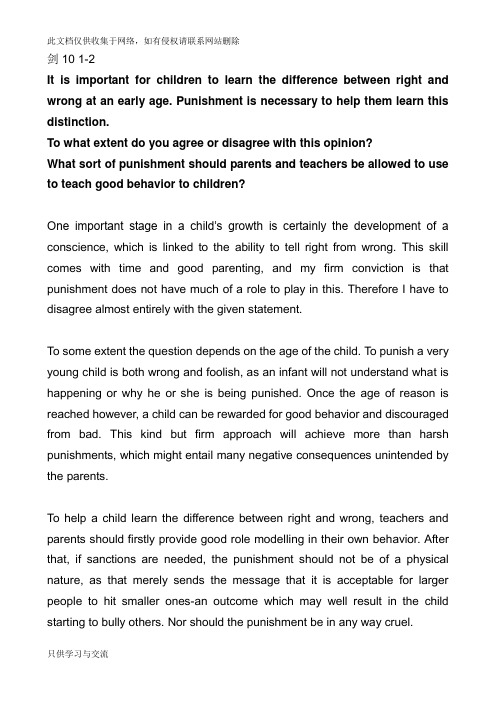
剑10 1-2It is important for children to learn the difference between right and wrong at an early age. Punishment is necessary to help them learn this distinction.To what extent do you agree or disagree with this opinion?What sort of punishment should parents and teachers be allowed to use to teach good behavior to children?One important stage in a child’s growth is certainly the development of a conscience, which is linked to the ability to tell right from wrong. This skill comes with time and good parenting, and my firm conviction is that punishment does not have much of a role to play in this. Therefore I have to disagree almost entirely with the given statement.To some extent the question depends on the age of the child. To punish a very young child is both wrong and foolish, as an infant will not understand what is happening or why he or she is being punished. Once the age of reason is reached however, a child can be rewarded for good behavior and discouraged from bad. This kind but firm approach will achieve more than harsh punishments, which might entail many negative consequences unintended by the parents.To help a child learn the difference between right and wrong, teachers and parents should firstly provide good role modelling in their own behavior. After that, if sanctions are needed, the punishment should not be of a physical nature, as that merely sends the message that it is acceptable for larger people to hit smaller ones-an outcome which may well result in the child starting to bully others. Nor should the punishment be in any way cruel.Rather, teachers and parents can use a variety of methods to discipline their young charges, such as detention, withdrawal of privileges, and time-out. Making the punishment fit the crime is a useful notion. Which would see children being made to pick up rubbish they have dropped, clean up graffiti they have drawn, or apologise to someone they have hurt. In these ways responsibility is developed in the child, which leads to much better future behavior than does punishment.剑10 2-1The tables below give information about sales of Fairtrade-labelled coffee and bananas in 1999 and 2004 in five European countries. Summarise the information by selecting and reporting the main features, and make comparisons where relevant.The two tables contain sales date for Fairtrade coffee and bananas in 1999 and 2004, in five nations of Europe.The first shows low-level coffee sales increasing in all five countries, albeit to widely varying degrees. In two places sales increased by the same small amount: 1.8-2 million euros in Denmark, and 0.8-1 million in Sweden. The increment was slightly larger in Belgium, from 1-1.7 million euros. Meanwhile, in Switzerland sales doubled from 3-6 million euros. Finally, in the UK there was an enormous increase, from 1.5-20 million euros.In the second table, it is Switzerland which stands out as buying far more Fairtrade bananas than the other four countries. Swiss sales figures jumpedfrom 15-47 million euros across these five years, while in the UK and Belgium sales only grew from 1-5.5 and from 0.6-4 million euros respectively. Sweden and Denmark showed a different pattern, with fails in banana sales from 1.8-1 and 2-0.9 million euros.Comparing the two tables, it is clear that in 1999 Fairtrade coffee sales ranged from 0.8-3 million euros in these five countries, while banana sales also mostly cluster between 0.6 and 2 million euros, with Switzerland the outlier at a huge 15 million euros. By 2004, sales figures for both products had risen across the board, except for Sweden and Demark which recorded drops in banana sales.剑10 3-2Countries are becoming more and more similar because people are able to buy the same products anywhere in the world.Do you think this is a positive or negative development?It is said that countries are becoming similar to each other because of the global spread of the same products, which are now available for purchase almost anywhere. I strongly believe that this modern development is largely detrimental to culture and traditions worldwide.A country’s history, language and ethos are all inextricably bound up in its manufactured artefacts. If the relentless advance of international brands into every corner of the world continues, these bland packages might one day completely oust the traditional objects of a nation, which would be a loss of richness and diversity in the world, as well as the sad disappearance of the manifestations of a place’s character. What would a Japanese tea ceremony be without its specially crafted teapot, or a Fijian kava ritual without its bowlmade from a certain type of tree bark?Let us not forget either that traditional products, whether these be medicines, cosmetics, toys, clothes, utensils or food, provide employment for local people. The spread of multinational products can often bring in its wake a loss of jobs, as people turn to buying the new brand, perhaps thinking it more glamorous than the one they are used to. This eventually puts old-school craftspeople out of work.Finally, tourism numbers may also be affected, as travellers become disillusioned with finding every place just the same as the one they visited previously. To see the same products in shops the world over is boring, and does not impel visitors to open their wallets in the same way that trinkets or souvenirs unique to the particular area do.Some may argue that all people are entitled to have access to the same products, but I say that local objects suit local conditions best, and that faceless uniformity worldwide is an unwelcome and dreary prospect.剑10 4-1The diagrams below show the life cycle of a species of large fish called the salmon.Summarise the information by selecting and reporting the main features, and make comparisons where relevant.Salmon begin life as eggs on a pebbly riverbed, hidden among reeds in the slow-moving upper reaches of a river. After five to six months the eggs hatch into “fry”. For approximately the next four years, these baby salmon will live in the lower, faster-flowing waters of their river. During this time they measure between three and eight centimetres in length.By the time salmon reach twelve to fifteen centimetres, they are termed ‘smolt’, and at this time they migrate further downriver into the open sea. After five years at sea the salmon will have grown to adult size, which is between seventy and seventy-six centimetres. They then begin swimming back to their birthplace, where they will lay their eggs, and the cycle starts anew.In summary, the salmon passes through three distinct physical stages as it grows to maturity. Each of these stages takes place in a very different aquatic location. It is noteworthy that the first two stages of this fish’s life occur in a freshwater environment, while the third stage is lived in saltwater.。
(完整版)剑桥英语10雅思考官范文(大作文小作文).doc
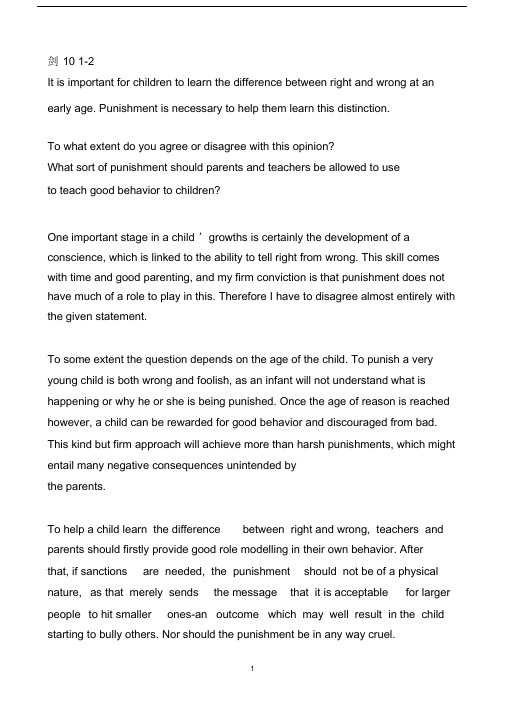
剑10 1-2It is important for children to learn the difference between right and wrong at an early age. Punishment is necessary to help them learn this distinction.To what extent do you agree or disagree with this opinion?What sort of punishment should parents and teachers be allowed to useto teach good behavior to children?One important stage in a child ’growths is certainly the development of a conscience, which is linked to the ability to tell right from wrong. This skill comes with time and good parenting, and my firm conviction is that punishment does not have much of a role to play in this. Therefore I have to disagree almost entirely with the given statement.To some extent the question depends on the age of the child. To punish a very young child is both wrong and foolish, as an infant will not understand what is happening or why he or she is being punished. Once the age of reason is reached however, a child can be rewarded for good behavior and discouraged from bad. This kind but firm approach will achieve more than harsh punishments, which might entail many negative consequences unintended bythe parents.To help a child learn the difference between right and wrong, teachers and parents should firstly provide good role modelling in their own behavior. After that, if sanctions are needed, the punishment should not be of a physical nature, as that merely sends the message that it is acceptable for larger people to hit smaller ones-an outcome which may well result in the child starting to bully others. Nor should the punishment be in any way cruel.Rather, teachers and parents can use a variety of methods to discipline their young charges, such as detention, withdrawal of privileges, and time-out. Making the punishment fit the crime is a useful notion. Which would see children being made to pick up rubbish they have dropped, clean up graffiti they have drawn, or apologise to someone they have hurt. In these ways responsibility is developed in the child, which leads to much better future behavior than does punishment.剑10 2-1The tables below give information about sales of Fairtrade-labelled coffee and bananas in 1999 and 2004 in five European countries.Summarise the information by selecting and reporting the main features,and make comparisons where relevant.The two tables contain sales date for Fairtrade coffee and bananas in 1999and 2004, in five nations of Europe.The first shows low-level coffee sales increasing in all five countries, albeit to widely varying degrees. In two places sales increased by the same small amount: 1.8-2 million euros in Denmark, and 0.8-1 million in Sweden. The increment was slightly larger in Belgium, from 1-1.7 million euros. Meanwhile,in Switzerland sales doubled from 3-6 million euros. Finally, in the UK therewas an enormous increase, from 1.5-20 million euros.In the second table, it is Switzerland which stands out as buying far more Fairtrade bananas than the other four countries. Swiss sales figures jumpedfrom 15-47 million euros across these five years, while in the UK and Belgium sales only grew from 1-5.5 and from 0.6-4 million euros respectively. Sweden and Denmark showed a different pattern, with fails in banana sales from 1.8-1 and 2-0.9 million euros.Comparing the two tables, it is clear that in 1999 Fairtrade coffee sales rangedfrom 0.8-3 million euros in these five countries, while banana sales also mostly cluster between 0.6 and 2 million euros, with Switzerland the outlier at a huge15 million euros. By 2004, sales figures for both products had risen across the board, except for Sweden and Demark which recorded drops in banana sales.剑10 3-2Countries are becoming more and more similar because people areable to buy the same products anywhere in the world.Do you think this is a positive or negative development?It is said that countries are becoming similar to each other because of the global spread of the same products, which are now available for purchase almost anywhere. I strongly believe that this modern development is largely detrimental to culture and traditions worldwide.A country ’s history, language and ethos are all inextricably bound up in its manufactured artefacts. If the relentless advance of international brands into every corner of the world continues, these bland packages might one day completely oust the traditional objects of a nation, which would be a loss of richness and diversity in the world, as well as the sad disappearance of the manifestations of a place’s character. What would a Japanese tea ceremonybe without its specially crafted teapot, or a Fijian kava ritual without its bowlmade from a certain type of tree bark?Let us not forget either that traditional products, whether these be medicines, cosmetics, toys, clothes, utensils or food, provide employment for local people. The spread of multinational products can often bring in its wake a loss of jobs,as people turn to buying the new brand, perhaps thinking it more glamorousthan the one they are used to. This eventually puts old-school craftspeople outof work.Finally, tourism numbers may also be affected, as travellers become disillusioned with finding every place just the same as the one they visited previously. To see the same products in shops the world over is boring, and does not impel visitors to open their wallets in the same way that trinkets or souvenirs unique to the particular area do.Some may argue that all people are entitled to have access to the same products, but I say that local objects suit local conditions best, and that faceless uniformity worldwide is an unwelcome and dreary prospect.剑10 4-1The diagrams below show the life cycle of a species of large fishcalled the salmon.Summarise the information by selecting and reporting the main features,and make comparisons where relevant.Salmon begin life as eggs on a pebbly riverbed, hidden among reeds in theslow-moving upper reaches of a river. After five to six months the eggs hatchinto “fry ”.For approximately the next four years, these baby salmon will live inthe lower, faster-flowing waters of their river. During this time they measure between three and eight centimetres in length.By the time salmon reach twelve to fifteen centimetres, they are termed‘smolt’, and at this time they migrate further downriver into the open sea. After five years at sea the salmon will have grown to adult size, which is between seventy and seventy-six centimetres. They then begin swimming back totheir birthplace, where they will lay their eggs, and the cycle starts anew.In summary, the salmon passes through three distinct physical stages as it grows to maturity. Each of these stages takes place in a very different aquatic location. It is noteworthy that the first two stages of this fish ’slife occur in a freshwater environment, while the third stage is lived in saltwater.。
- 1、下载文档前请自行甄别文档内容的完整性,平台不提供额外的编辑、内容补充、找答案等附加服务。
- 2、"仅部分预览"的文档,不可在线预览部分如存在完整性等问题,可反馈申请退款(可完整预览的文档不适用该条件!)。
- 3、如文档侵犯您的权益,请联系客服反馈,我们会尽快为您处理(人工客服工作时间:9:00-18:30)。
剑10 1-2It is important for children to learn the difference between right and wrong at an early age・ Punishment is necessary to help them learn this distinctio n. To what extent do you agree or disagree with this opinion?What sort of punishment should parents and teachers be allowed to use to teach good behavior to children?One important stage in a child's growth is certainly the development of a conscience, which is linked to the ability to tell right from wrong・ This skill comes with time and good parenting, and my firm conviction is that punishment does not have much of a role to play in this・ Therefore I have to disagree almost entirely with the given statement.To some extent the question depends on the age of the child・ To punish a very young child is both wrong and foolish, as an infant will not understand what is happening or why he or she is being punished・Once the age of reason is reached however, a child can be rewarded for good behavior and discouraged from bad・This kind but firm approach will achieve more than harsh punishments, which might entail many negative consequences unintended by the parents.To help a child learn the difference between right and wrong, teachers and parents should firstly provide good role modelling in their own behavior. After that, if sanctions are needed, the punishment should not be of a physical nature, as that merely sends the message that it is acceptable for larger people to hit smaller ones-an outcome which may well result in the child starting to bully others・ Nor should the punishment be in any way cruel.Rather, teachers and parents can use a variety of methods to discipline their young charges, such as detention, withdrawal of privileges, and time-out. Maki ng the punishment fit the crime is a useful notion. Which would see children being made to pick up rubbish they have dropped, clean up graffiti they have drawn, or apologise to someone they have hurt・ In these ways responsibility is developed in the child, which leads to much better future behavior than does punishment.The tables below give information about sales of Fairtrade-labelled coffee and bananas in 1999 and 2004 in five European countries・ Summarise the information by selecting and reporting the main features, and make comparisons where relevant.* Fairtrade: a category of products for which farmo ,offic/y agreed fair price. 陀「$from developing countries have been paid anThe two tables contain sales date for Fairtrade coffee and bananas in 1999 and 2004, in five nations of Europe・The first shows low-level coffee sales increasing in all five countries, albeit to widely varying degrees・ In two places sales increased by the same small amount: 1.8-2 million euros in Den mark, and 0.8-1 million in Swede n. The increment was slightly larger in Belgium, from 1-1.7 million euros・ Meanwhile, in Switzerland sales doubled from 3-6 million euros・ Finally, in the UK there was an enormous increase, from 1.5-20 million euros・In the second table, it is Switzerland which stands out as buying far more Fairtrade bananas than the other four countries・ Swiss sales figures jumped from 15-47 million euros across these five years, while in the UK and Belgium sales only grew from 1-5.5 and from 0.6-4 million euros respective!y. Sweden and Denmark showed a different patter n, with fails in ban ana sales from 1.8-1 and 2-0.9 million euros・Comparing the two tables, it is clear that in 1999 Fairtrade coffee sales ranged from 0.8-3 million euros in these five countries, while banana sales also mostly cluster between 0.6 and 2 million euros, with Switzerland the outlier at a huge 15 million euros・By 2004, sales figures for both products had risen across the board, except for Sweden and Demark which recorded drops in banana sales.剑10 3-2Countries are becoming more and more similar because people are able to buy the same products anywhere in the world・Do you think this is a positive or negative development?It is said that countries are becoming similar to each other because of the global spread of the same products, which are now available for purchase almostanywhere・ I strongly believe that this modern development is largely detrimental to culture and traditions worldwide.A country's history, language and ethos are all inextricably bound up in its manufactured artefacts .If the relentless advance of international brands into every corner of the world continues, these bland packages might one day completely oust the traditional objects of a nation, which would be a loss of richness and diversity in the world, as well as the sad disappearanee of the manifestations of a place's character. What would a Japanese tea ceremony be without its specially crafted teapot, or a Fijian kava ritual without its bowl made from a certain type of tree bark?Let us not forget either that traditional products, whether these be medicines, cosmetics, toys, clothes, utensils or food, provide employment for local people. The spread of multinational products can often bring in its wake a loss of jobs, as people turn to buying the new brand, perhaps thinking it more glamorous than the one they are used to. This eventually puts old-school craftspeople out of work.Finally, tourism numbers may also be affected, as travellers become disillusioned with finding every place just the same as the one they visited previously. To see the same products in shops the world over is boring, and does not impel visitors to open their wallets in the same way that trinkets or souvenirs unique to the particular area do.Some may argue that all people are entitled to have access to the same products, but I say that local objects suit local conditions best, and that faceless uniformity worldwide is an unwelcome and dreary prospect.剑 10 4-1The diagrams below show the life cycle of a species of large fish called the salmon ・Summarise the information by selecting and reporting the main features, and make comparisons where relevant.Salmon begin life as eggs on a pebbly riverbed, hidden among reeds in the slow-moving upper reaches of a river. After five to six months the eggs hatch into “fry”. For approximately the next four years, these baby salmon will live in the lower, faster-flowing waters of their river. During this time they measure between three and eight centimetres in length.By the time salmon reach twelve to fifteen centimetres, they are termed 'smolt ; and at this time they migrate further downriver into the open sea. After five years at sea the salmon will have grown to adult size, which is between seventy and101seventy-six centimetres・ They then begin swimming back to their birthplace, where they will lay their eggs, and the cycle starts anew.In summary, the salmon passes through three distinct physical stages as it grows to maturity. Each of these stages takes place in a very different aquatic location. It is noteworthy that the first two stages of this fish's life occur in a freshwater environment, while the third stage is lived in saltwater.。
